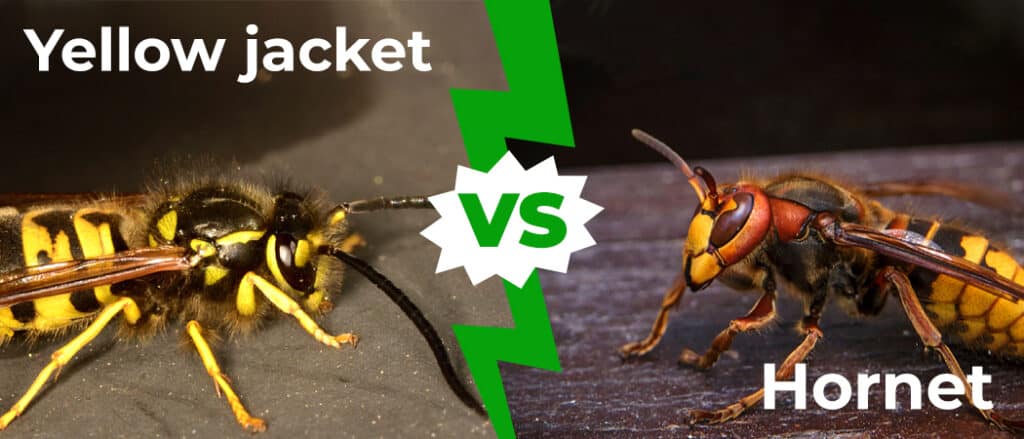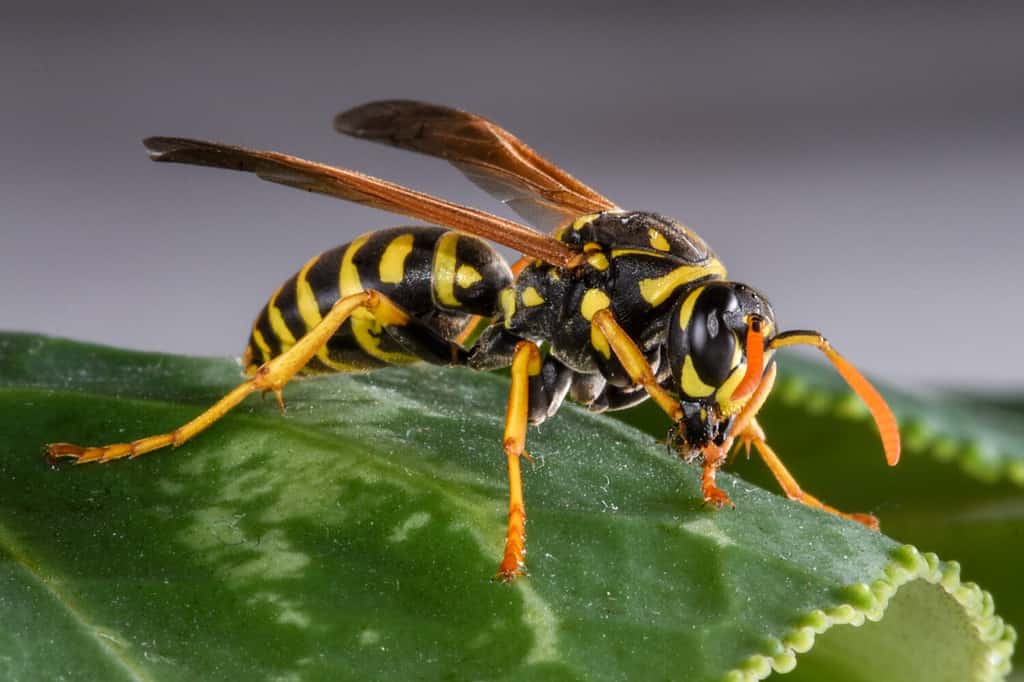If you saw a yellow jacket and a hornet sitting on a piece of fruit, you may assume they’re the same type of insect. After all, they look similar and both belong to the Vespidae family. But, upon closer study, you’ll see these two insects have several significant differences.
For one, a yellow jacket is smaller than a hornet. The coloration on their bodies is a little different, too. Also, there is a difference between their diets.
Do yellow jackets and hornets build the same type of nest? Which of these two insects is more likely to sting a human? Why are yellow jackets known as ‘meat wasps’?
Read on to uncover the answers to these questions and more facts about hornets vs yellow jackets.
Comparing Yellow Jacket vs Hornet

| Hornet | Yellow Jacket | |
|---|---|---|
| Size (Length): | 1.3 – 2.2 inches | Up to 1 inch |
| Diet: | Insects, fruit | Insects, fruit, carrion |
| Nest Location: | Inside walls, in trees | Underground |
| Nest Type: | Cone shape | Tunnels and cells |
| Color: | Brown/yellow, black, red | Black, yellow |
| Aggressive Behavior: | Stings multiple times | Stings and bites |
| Average Flying Speed: | 14 mph | 6-7 mph |
Yellow Jacket vs Hornet: The 7 Key Differences

Feeding on a carnivorous diet, yellow jackets primarily prey on other insects like flies and bees.
©Randy Runtsch/Shutterstock.com
1. Size
A yellow jacket and hornet are similar in that they both have a pair of wings, six spindly legs, and a narrow section separating their abdomen and thorax. But look at their size and you’ll find a hornet is much bigger than a yellow jacket.
A yellow jacket is about 1 inch in length while a hornet’s body can be 1.3 to 2.2 inches long.
2. Diet
One glance at the list of items included in the diet of both yellow jackets and hornets and you’ll see lots of the same things. However, there’s one very different item eaten by the yellow jacket.
Flies, caterpillars, fruit, and beetles are eaten by both yellow jackets and hornets. Also, both insects drink nectar. What makes the diet of the yellow jacket different is it consumes carrion aka dead animal meat. Yellow jackets are the ones most likely to be seen buzzing around dumpsters full of discarded food and hovering around roadkill on highways. This activity has earned them the name ‘meat wasp.’
3. Nest Location
Most yellow jackets are known to build their nests beneath the ground. Generally, they dig a hole in a patch of mud or dirt and burrow a tunnel down to create the nest. Some yellow jackets use burrows abandoned by other small animals. As a note, there are a few species of yellow jackets that build nests above ground.
Hornets build their nests beneath the branches of trees or shrubs. They sometimes create a nest beneath an eave of a house. A homeowner may even find a hornet nest inside a wall.
4. Nest Type
Nest type is one of the most notable differences between this pair of fliers. The nest of a hornet is cone-shaped with a papery surface. Hornets make their nest by chewing up pieces of wood pulp. Little by little, the wood pulp combined with their saliva helps build the walls of the nest.
Yellow jackets dig a tunnel and construct a nest made of wood pulp material. The nest contains cells or compartments for the workers and the queen. There’s usually just one entrance the leads to the nest beneath the ground. Some yellow jacket nests have been found four feet below the surface!
Not surprisingly, these nests are difficult to find unless someone is looking for lots of yellow jackets coming and going.
5. Color
Yellow jackets are easily recognizable for the yellow and black striped pattern on their abdomen. They have yellow and black splotches on their thorax and head.
Hornets have similar yellow and black markings on their abdomen too. What makes them different from yellow jackets is the red combined with the black on their head and thorax.
6. Aggressive Behavior
Both of these insects have a venomous sting. A hornet can sting a person multiple times very quickly. Yellow jackets sting and can bite as well.
The venomous liquid released by yellow jackets and hornets causes irritation and pain in the area where the sting penetrates the skin.
A sting from either of these insects can be potentially deadly if someone has an allergic reaction to the venomous liquid.
Biologists have found that yellow jackets are more aggressive than hornets. Of course, they can become aggressive when someone gets near their nest. In addition to that, yellow jackets have been known to sting people for no reason at all.
7. Average Flying Speed
Yellow jackets and hornets can fly at high speeds. But hornets have been observed to fly a little faster than yellow jackets. Hornets fly at an average speed of 14 mph while yellow jackets fly at an average speed of 6 to 7 mph.
What is the Most Aggressive Yellow Jacket?

The German yellowjacket is the most aggressive species of yellowjacket in the world.
©tasnenad/Shutterstock.com
German yellowjackets, also known as Vespula germanica, are invasive hornets that protect their nests really aggressively. This invasive predator insect has been pushing out and invading other species such as the Western yellowjacket.
The German yellowjacket can actually string many times and will attack anything that threatens their nest or nearby territory.
When wasps and yellow jackets sense a threat, they become more defensive and will take action to eliminate the danger from the nest’s vicinity, even if it means stinging you.
Further, these types of yellowjackets can follow an attack long-distance.
The photo featured at the top of this post is ©
FAQs (Frequently Asked Questions)
What’s worse a yellow jacket or a hornet?
Though a hornet is larger, the average person is more likely to be stung by a yellow jacket. This is because yellow jackets live and move around in the same space as people. They buzz around garbage cans in the local park, hang around filled dumpsters, and land on cups filled with sugary drinks.
Yellow Jacket vs Hornet: Which is more venomous?
Both types of insects can inject 2 to 15 micrograms of venom per sting. A hornet is known to give multiple stings in a matter of seconds. So, if someone receives multiple stings from a hornet, then it would be more venomous than a yellow jacket that stings once or twice.
Thank you for reading! Have some feedback for us? Contact the AZ Animals editorial team.






